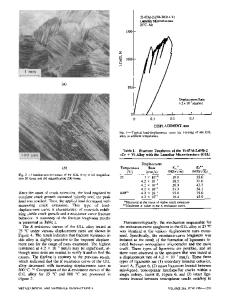Micro Fracture Toughness Testing of TiAl Based Alloys with a Fully Lamellar Structure
- PDF / 1,837,613 Bytes
- 6 Pages / 612 x 792 pts (letter) Page_size
- 8 Downloads / 397 Views
S5.44.1
Micro Fracture Toughness Testing of TiAl Based Alloys with a Fully Lamellar Structure K. Takashima, T. P. Halford, D. Rudinal, Y. Higo and M. Takeyama1 Precision and Intelligence Laboratory, Tokyo Institute of Technology, R2-35 4259 Nagatsuta, Midori-ku, Yokohama, 226-8503, Japan 1 Department of Metallurgy and Ceramics Science, Tokyo Institute of Technology, S8-8 2-12-1 Ookayama, Meguro-Ku, Tokyo, 152-8552, Japan ABSTRACT A micro-sized testing technique has been applied to investigate the fracture properties of lamellar colonies in a fully lamellar Ti-46Al-5Nb-1W alloy. Micro-sized cantilever specimens with a size ≈ 10 x 10 x 50 µm3 were prepared by focused ion beam machining. Notches with a width of 0.5 µm and a depth of 5 µm were also introduced into the micro-sized specimens by focused ion beam machining. Fracture tests were successfully completed using a mechanical testing machine for micro-sized specimens at room temperature. The fracture toughness (KQ) values obtained were in the range 1.4 – 7 MPam1/2. Fracture surface observations indicate that these variations are attributable to differences in local lamellar orientations ahead of the notch. These fracture toughness values are also lower than those having been previously reported in conventional samples. This may be due the absence of significant extrinsic toughening mechanisms in these micro-sized specimens. Fracture mechanisms of these alloys are also considered on the micrometer scale. The results obtained in this investigation give important and fundamental information on the development of TiAl based alloys with high fracture toughness. INTRODUCTION TiAl (γ) based aluminides have been developed as candidate materials for gas turbine engine components to replace existing nickel based superalloys. This is because of their high specific strength and modulus coupled with their relatively good elevated temperature strength, oxidation resistance and creep properties [1, 2]. Their disadvantages, which include poor room temperature ductility, low fracture toughness and difficult fabricability, have, however, restricted industrial applications. Gamma single phase alloys are essentially very brittle. In contrast, mechanical properties are improved for two phase alloys containing small amount of Ti3Al (α2) [3]. Their mechanical properties depend strongly upon microstructure, which varies widely with differing heat-treatments [4]. The microstructures of (γ+α2) alloys of interest can be roughly divided into lamellar and duplex microstructures. The lamellar microstructure has a good balance of elevated temperature properties and fracture toughness. This increased fracture toughness, relative to duplex structures, is attributed to crack tip shielding by extrinsic toughening mechanisms, including shear ligament bridging [5]. These extrinsic toughening mechanisms are dominated by microscopic lamellar structures including lamellar orientation [6, 7], colony size [8] and plate thickness [9]. It is therefore important to investigate the fracture properties of lame
Data Loading...











